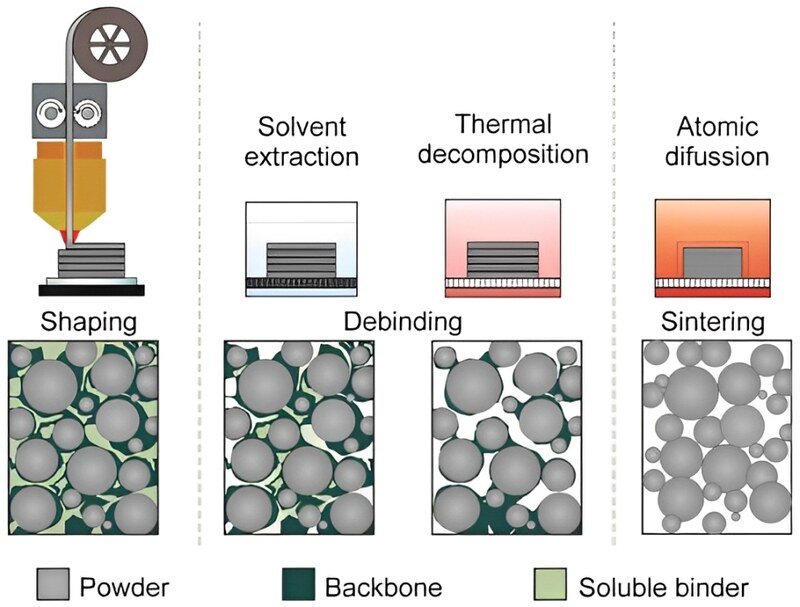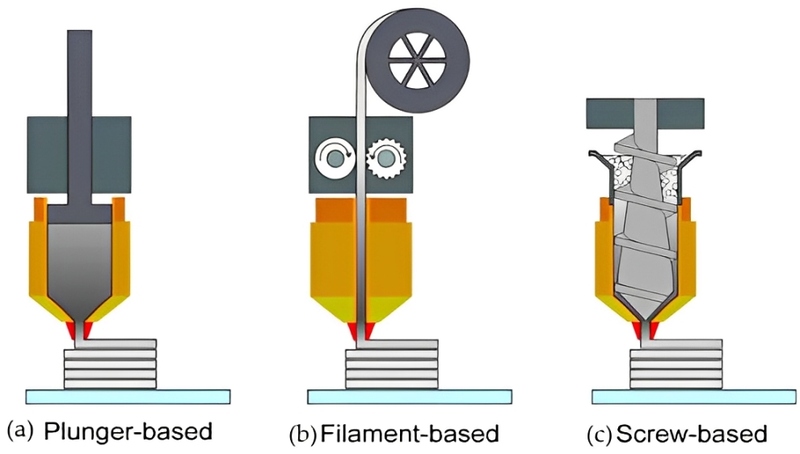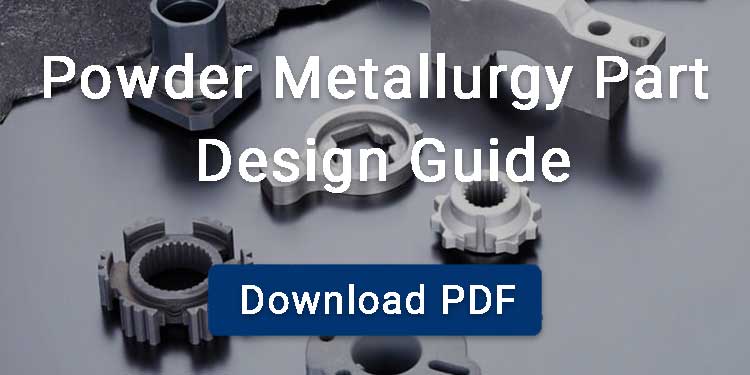Material extrusion is one of the seven globally recognized additive manufacturing processes. It has helped in transforming prototypes and producing complex parts. It is unique because it is simple, cost-effective, and easily accessible. It plays an important role in applications where customizing, using various materials, and processing speed are critical.
Material extrusion stands out in desktop and industrial 3D printers, where it ensures that objects are fabricated layer-by-layer. Compared to traditional extrusion, which creates continuous shapes using a die, material extrusion melts and deposits the material in specific patterns to form 3D objects.
Contents
What is Material Extrusion?
Material extrusion is an AM technique used to build 3D parts layer by layer through the continuous deposition of a filament of thermoplastic or composite materials. The filament is deposited in 2D sliced layers using a heated nozzle.
The first patented and commercialized material-extrusion system was Fused Deposition Modelling (FDM), invented by S. S. Crump and commercialized by Stratasys in 1989. However, it is also called Fused Filament Fabrication (FFF), by a broader audience of manufacturers.
The material extrusion market survey reports project that it has a Compound Annual Growth Rate, CAGR, of 13.5%. The market, which recorded USD 10.5 billion in 2024, is expected to hit USD 25.7 billion by 2033, thanks to increasing consumer demands and industry adoptions.
Material Extrusion Process
The material extrusion process typically follows a systematic sequence:
Loading the Material
The process begins by feeding a thermoplastic filament, pellet, paste, or other suitable form of material into the printer.
Heating/Melting
The material passes through a heated zone where it reaches its melting point, making it soft and viscous enough to flow but not so liquid that it flows away from where it is applied.
Extruding Through a Nozzle
The molten or viscous material is pushed through a small nozzle, usually with the help of a drive mechanism or plunger system.
Layer-by-Layer Deposition
The print head or build platform moves in pre-programmed paths (based on a CAD model), depositing material one layer at a time in 2D slices. Each layer cools and solidifies before the next layer is applied, and they combine to form the complete 3D object.

Materials Used in Material Extrusion
Material extrusion supports a wide range of materials, each offering unique properties for different applications:
Thermoplastics and Polymers
The polymers and thermoplastics commonly used include PLA (Polylactic Acid), ABS (Acrylonitrile Butadiene Styrene), and PETG (Polyethylene Terephthalate Glycol). They are widely used because they are printable, strong, and easily available.
Composites and Fiber-Reinforced Materials
Composites like thermoplastics reinforced with carbon fibers, glass fibers, or metal particles, are also materials used for extrusion. They ensure improved mechanical performance.
Flexible and Specialty Filaments
TPU (Thermoplastic Polyurethane), conductive filaments, and temperature-resistant plastics expand the range of possible use cases.
Pellets and Pastes
Materials such as raw plastic pellets or ceramic clay (paste) are used for extrusion as well. These are vital in various industries, for example, in the health sector, via the production of bio-materials for medical applications.
Types of Material Extrusion Techniques
Material extrusion has several techniques that depend on the function and form of the material in use, to mention a few:
Fused Filament Fabrication (FFF)
Also known as Fused Deposition Modelling, and is the most common material extrusion technique. It uses spooled filament that has been melted and extruded through a heated nozzle, which is deposited on a preheated build.
Pellet Extrusion
A technique that is a bit similar to both FDM and Injection molding. It feeds the pellets to a nozzle via a screw and barrel system like in injection molding, and extrudes it to build up parts layer by layer like in FDM. Pellet extrusion in AM is also known as Fused Granulate Fabrication, FGF.
Paste or Clay Extrusion
The paste or clay extrusion is done through either the ram extruder mechanism, auger valve extrusion mechanism, or the needle valve extrusion mechanism. These three mechanisms consist of a syringe and plunger system but their extrusion processes differ.
Bio-material Extrusion
Also known as extrusion bioprinting, is a technique that involves the extrusion of bioinks through a nozzle to create structures that can mimic tissues or organ functions.

Material Extrusion Advantages and Disadvantages
Advantages
Low Cost
The equipment and materials used cost relatively less, making it ideal for beginners and educational settings.
Accessibility
Desktop 3D printers using material extrusion are widely available, easy to learn, and user-friendly.
Material Diversity
Material extrusion supports a variety of thermoplastics, composites, and specialty materials.
Customization
It allows for rapid prototyping and on-demand production of customized parts.
Disadvantages
Surface Finish
Extruded parts often require post-processing due to visible layer lines and rough surfaces.
Anisotropy
Strength varies depending on the print orientation; for example, parts may be weaker along the Z-axis.
Limited Material Strength
Compared to other AM processes like powder bed fusion, material extrusion may yield lower mechanical properties.
Material Extrusion Applications
Material extrusion is used across several industries for different purposes, including:
Rapid Prototyping
Engineers and designers use it to create functional prototypes quickly and cost-effectively.
End-Use Parts
In sectors like automotive and aerospace, material extrusion is used to produce jigs, fixtures, and low-volume production parts.
Biomedical
It is used to fabricate scaffolds, prosthetics, and also bioprinted tissues for medical uses.
Architecture and Construction
Large-scale paste extrusion is employed for printing concrete structures and architectural components.
Food Packaging
It is also used to produce edible foods such as chocolates and other snacks, cereals, pasta, etc.
Material Extrusion in Additive Manufacturing
Material extrusion is one of the seven standard additive manufacturing processes defined by ASTM. It is usually the first method new users are exposed to because it is affordable and simple. Contrary to powder-based methods, it does not require a controlled atmosphere or post-sintering. This makes it more accessible to small businesses and individuals.
As the industry evolves, material extrusion continues to expand into industrial domains where customized tooling, short-run production, and complex geometries are required.
What Is the Difference Between Material Jetting and Material Extrusion?
The following table explains the differences between material jetting and material extrusion.
| Criteria | Material Extrusion | Material Jetting |
|---|---|---|
| Process | Applies partially melted material in lines and dots. Resolution: ~0.5–1 mm. | Applies liquid resins in droplets. Resolution: often smaller than 0.05 mm. |
| Layer Construction | Uses a single applicator nozzle. Build speed is limited by nozzle travel. | Uses wide inkjet heads (up to 100 mm) to draw full stripes per pass — faster. |
| Z-Layer Builds | Builds thicker layers (0.1 mm to 0.5 mm), enabling fewer, faster layers. | Builds ultra-thin layers (16–50 µm), requiring more layers and time. |
| Cost of Equipment | Equipment is relatively simple and inexpensive (FDM/FFF). | Equipment is complex and expensive (1–2 orders of magnitude more than FDM). |
FAQ
What Is the Difference Between Material Extrusion and Traditional Extrusion?
Material extrusion (3D printing) builds parts layer by layer from digital files, great for prototypes and complex shapes. It’s precise, flexible, and has low setup costs.
Traditional extrusion pushes material through a die to make continuous shapes like pipes or sheets. It’s less precise but efficient for mass production, though setup costs are higher.
In short, 3D extrusion suits custom, small-batch parts, while traditional extrusion is best for high-volume, uniform products.



